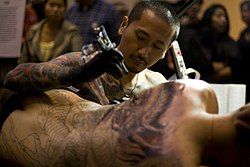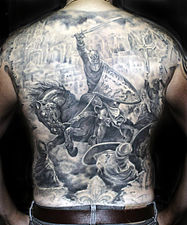Body suit (tattoo)
This article needs additional citations for verification. (April 2021) |


A body suit or full body suit is an extensive tattoo, usually of a similar pattern, style or theme that covers the entire torso or the entire body.[1] They are associated with traditional Japanese tattooing as well as with some freak show and circus performers.[2] Such suits are of significant cultural meaning in some traditional cultures, representing a rite of passage, marriage or a social designation.
History[]
The body suit first came into prominence in Japanese culture in the form of irezumi, a Japanese tattooing style.[3] In Japan during the Edo period (1603–1867 CE), tattooing gained popularity and was considered to be a form of art.[3] However, tattooing was made illegal near the end of the Edo period, in an effort by the Japanese government to protect its image abroad.[3] At this time, tattooing was done clandestinely, and tattoos became associated with the Japanese Yakuza organized crime syndicates, who began to incorporate the full body suit as part of their organizations' identities.[3] Such body suits were performed using tebori, a traditional Japanese style that involves tattooing by hand, sans the use of any machines.[3] At this time, it was common for the hands, face and neck to not be tattooed, although Japanese body suits often included tattooing on genitalia.[3]
It has also been stated that the body suit originated in Japan around 1700 CE, as a means for working middle-class people to display their wealth and status.[4] Laws were in place that only allowed nobility to dress in fancy clothing, so some in the middle class chose tattoos as a means to adorn their bodies.[4]
Full sleeve[]

A 'full sleeve' is a tattoo which completely covers an arm, from the shoulder to the wrist. A 'full sleeve' can be part of a 'full body suit'.
Backpiece[]
A 'backpiece' is a tattoo which largely or completely covers the back, and can be part of a 'full body suit'.
Notable wearers[]
See also[]
- Body modification
- Body painting
- Lower back tattoo
- Pe'a
References[]
- ^ DeMello, M. (2014). Inked: Tattoos and Body Art around the World [2 volumes]. ABC-CLIO. p. 731. ISBN 978-1-61069-076-8. Retrieved April 21, 2021.
- ^ a b c d e f DeMello, M. (2014). Inked: Tattoos and Body Art around the World [2 volumes]. ABC-CLIO. pp. 224–225. ISBN 978-1-61069-076-8. Retrieved April 21, 2021.
- ^ a b c d e f "50 Remarkable Bodysuit Tattoos". Inked. November 4, 2020. Retrieved April 21, 2021.
- ^ a b Green, T. (2009). The Tattoo Encyclopedia: A Guide to Choosing Your Tattoo. Touchstone. p. 12. ISBN 978-1-4391-8869-9. Retrieved April 21, 2021.
External links[]
| Wikimedia Commons has media related to Bodysuit tattoos. |
- "Full Body Tattoo Transformation", BellaOnline.com at the Wayback Machine (archived 18 June 2013) History, culture, and pictures.
- Body modification
- Tattooing by body part
- Body modification stubs



